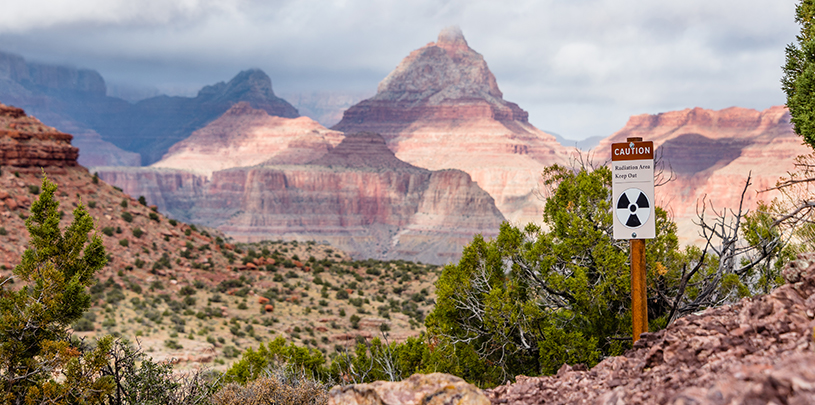
 by Amber Reimondo, Energy Director
by Amber Reimondo, Energy Director
On August 8, 2023, the president designated Baaj Nwaavjo I’tah Kukveni – Ancestral Footprints of the Grand Canyon National Monument, protecting 917,618 acres of public land north and south of Grand Canyon National Park at the request of Native American tribes.
While the national monument preserves access for hunting, livestock grazing, and other traditional uses, it bars new mining claims from being staked inside the monument. However, any mine that has established valid existing rights — like Canyon Mine (aka Pinyon Plain Mine) in the south parcel of the new monument — can still move forward.
It’s unlikely there are many of these, however. The Biden administration estimated that only two mines within the monument are in any position to move forward.
The monument designation, popular with Arizona voters, nonetheless sparked outrage among some domestic uranium boosters, who claimed the new monument would make the U.S. dependent on Russia for uranium imports.
Setting aside the fact that this argument displays a fundamental misunderstanding of uranium resources across the newly designated monument lands — the amount of uranium found within the monument boundaries is miniscule compared to reserves elsewhere in the country and in the world — let's take a look at where, in reality, the U.S. got its uranium in 2022.

Whether you think the U.S. should be using uranium or not, let’s just look at the numbers. U.S. power plants purchased the bulk of their uranium from foreign suppliers in 2022, which makes sense, since the U.S. only has about 1 percent of world uranium reserves. The truth is uranium is plentiful and cheaper elsewhere.
In 2022, more than a quarter of U.S. uranium imports came from just one country: Canada. Just over 60 percent came from nine other countries, including Australia and Germany. Twelve percent came from Russia.
When it comes to replacing that 12 percent, it's worth remembering that two U.S. allies — Canada and Australia — combined possess nearly 40 percent of world uranium reserves. Uranium is plentiful throughout the world, and, by comparison, the U.S. doesn't have much of it. And, importantly, very little of what we do have is located in the Grand Canyon region.

Of course, historically, uranium mines did operate in the broader region, including on the Navajo Nation, as well as inside what is now Baaj Nwaavjo I'tah Kukveni, as well as inside Grand Canyon National Park. These mines have left behind a costly legacy that plagues the region to this day, and has devastated the Navajo Nation, so much so that in 2005 the Navajo Nation passed a law prohibiting all uranium mining on its lands.
Mining speculators certainly have had big hopes for mining around the Grand Canyon, staking hundreds of mining claims in what is now the monument. But these claims are just markers in the dirt at this point.
However, the White House fact sheet about the monument makes clear that: "Existing mining claims...will remain in place, and the two approved mining operations within the boundaries of the monument would be able to operate."
According to John Leshy, who served as the U.S. Department of the Interior’s solicitor during the Clinton administration, "It’s frankly very unlikely that any existing claims would be valid,” although each claim would have to be evaluated individually.

There's only one active uranium mine in the monument footprint — the infamous Canyon Mine (renamed Pinyon Plain Mine). Even though it broke ground in the 1980s, nearly 40 years later it has yet to commercially produce a single pound of uranium. Why? Because Canyon Mine's uranium is expensive to mine and the mine's owner appears to be waiting for prices to rise further to start mining. And they've been waiting for decades.
In 2018, a mine executive claimed Canyon Mine could be viable if uranium prices increased to $40-$50 per pound by 2019. That didn’t happen. As of September 2023, though, spot prices had hit $70 per pound, but while activity at the mine has increased, mining has yet to commence. In December 2022, a mine spokesperson said mining was likely "at least a year away."
Even if the mine does start to extract uranium, the mine’s technical report shows it’s expected to produce about 2.3 million pounds of uranium (processed uranium, not uranium ore — ore is what’s taken from the mine to be processed, but it includes over 99 percent waste rock) over its lifetime. For context, U.S. nuclear reactors consume around 40 million pounds of uranium each year. So even if Canyon Mine does ever get moving, the company’s operations won’t impact U.S. uranium supplies much.
Meanwhile, the mine sits, fenced off in a meadow on Kaibab National Forest land, now inside Baaj Nwaavjo I’tah Kukveni – Ancestral Footprints of the Grand Canyon National Monument, just a few miles from the sacred site of Red Butte.
While mining companies lock up public lands — the ancestral lands of Indigenous peoples — national monument protections keep public lands public, for all to enjoy. The new Baaj Nwaavjo I’tah Kukveni National Monument has never been and could never be key to the U.S. uranium supply. The land is now as it should be: permanently protected from additional unnecessary and harmful uranium mining.
Please let the U.S. Environmental Protection Agency Office of Environmental Justice and the U.S. Forest Service know that you oppose Canyon Mine (renamed Pinyon Plain Mine) near the Grand Canyon.
Groundwater pumping at a uranium mine near the Grand Canyon will affect the canyon's springs, scientists says.
Read MoreA rally in Salt Lake City followed by a spiritual walk in White Mesa demonstrate the Ute community's determination to see uranium mill close.
Read MoreArizona Governor Katie Hobbs is the latest elected official to call for an environmental review of Pinyon Plain uranium mine.
Read More